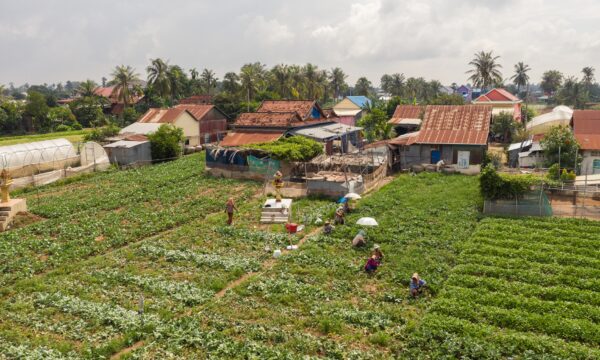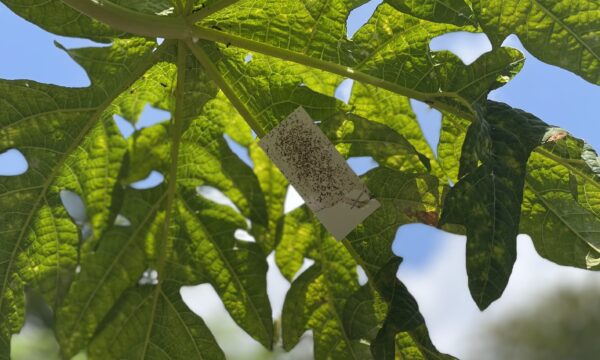
Farmer from Teso, Kenya. Indigenous knowledge of orphan crops should be conserved © Bioversity International/ Y.Wachira
The term ‘orphan crops’ refers to plant species and varieties that of recent decades have been ignored by governments, seed companies and scientists due to their limited importance in global markets. Instead, only a few major staples have been of interest. From fruits and vegetables to grains and nuts, many orphan crops are highly nutritious, resilient to climate extremes and are well adapted to marginal soils. They are therefore of great significance for food security and the generation of income to the world’s poorest communities.
According to the FAO, out of a total of 300,000 plant species only 10,000 have been used for human consumption and out of these only an estimated 150-200 plant species have been grown commercially. Today, 50% of the world’s energy needs are supplied by only four plant species: rice, wheat, maize and potatoes. Reliance on only a few major staples leaves farmers vulnerable to damage from pests and diseases, climate changes and poor soils. Increasing crop genetic diversity will increase the resilience of agroecosysems to changes in climate and environment and help to stabilise yields. Crop diversification through the increased interest and research of orphan crops is therefore a fundamental tool to increase global food security. Kebebew Assefa, a senior researcher at the Ethiopian Institute of Agricultural Research stated that ‘For poor nations in Africa, the need to improve their neglected, but locally significant, crops is no longer an option but a dire need.’
Examples of orphan crops
Finger millet
Finger millet is one of the world’s oldest grains and has been widely cultivated in India and Nepal for thousands of years. In recent decades, due to the deployment of high-yielding crop varieties and interest focusing on globally traded crops, locally important crops such as finger millet became marginalised. New crops that have replaced millet have not reached its high nutritional content. Millet is high in starch and iron and contains a high content of methionine, an amino acid that is lacking in many starchy crops.
Quinoa
On the other side of the world, in the Andean regions, quinoa has been cultivated for centuries. Quinoa is a grain crop grown mainly for its edible seeds. It is not a true cereal but is closely related to species such as spinach and beetroot. Its high nutritional value has had a significant contribution to Andean food security. Up until recently, the grain was almost unheard of outside of the Andes. However quinoa has now become one of the world’s trendiest foods. With a high proportion of protein and low carbohydrate content compared to maize and rice, it is now a common feature in many high-end restaurants and health food stores. Quinoa has recently been recognised for its climate resilience and ability to grow in diverse conditions. Sven-Erik Jacobsen, associate professor at the department of plant and environmental sciences at the University of Copenhagen stated “If you go to the south of Bolivia, you’re 3,600 metres above sea level, with 200mm of rain, and there are 200 nights with frosts. There’s only one crop you can grow and that’s quinoa, and this is why it has potential for many parts of the world.” Due to export markets, only a few varieties of quinoa have been associated with the recent boom. Local varieties requiring traditional farming techniques are being abandoned by farmers. The UN coined 2013 as ‘The International Year of Quinoa’ and has implemented programs to encourage farmers to grow threatened, local varieties.
Cañahua
Cañahua is a grain crop, closely related to quinoa and also grown in the high Andes. The genetic diversity of cañahua is fading rapidly. Today 85% of farmers growing cañahua grow only one variety, a small proportion of the once 200 varieties cultivated. This grain offers resilience to climate changes and a high nutritional content.
Teff
Teff is a gluten free grain crop, rich in nutrients. It is grown widely in Ethiopia and is a staple for 50 million Ethiopians. The tiny seeds of teff can be ground into flour to make bread. Just like quinoa, teff is experiencing a surge of interest from developed countries due to its recently rediscovered high nutritional value. This may preserve the rural incomes; however there are nutritional consequences to rural areas associated with exporting an entire crop to meet the growing western demand.
Finger millet, quinoa, cañahua and teff are classic examples of the types of struggles orphan crops face in modern agriculture. Bioversity International is working to promote the conservation and cultivation of orphan crops. They are encouraging farmers to grow orphan crops by establishing market outlets for them, mapping the genetic diversity of certain threatened species and setting up initiatives such as ‘Payments for Agrobiodiversity Conservation Services’ (PACS).
References
- New Agriculturalist (Nov 2013) Research and policy for orphan crops.
- Sci Dev Net (27th Jan 2014) The dire need to support ‘orphan crop’ research.
- The Guardian (21st Feb 2014) Climate change: will quinoa weather the storm?
- The Guardian (23rd Jan) Move over quiona, Ethiopia’s teff poised to be the next big super grain.
- Bioversity International (2013) Creating markets for orphan crops.
- Bioversity International (2013) Harvesting quiona diversity with Payment for Agrobiodiversity Conservation Services.
4 Comments
Leave a Reply
Related News & Blogs
The role of soil health in sustainable agriculture
Previously, we have discussed the importance of soil health for agriculture, highlighting its threats and outlining protection strategies. In this blog, we dig deeper into the role of soil health in sustainable agriculture and explore its long-term ben…
18 June 2025








The so called “orphan crops” should be considered as highly important in designing future cropping system to avoid monocultures and consequently its problems
Reblogged this on because the happiness index isn't cutting it and commented:
Great story from PW blog on ‘Orphan Crops’ and what this really means.
[…] impacts for farm businesses: Practical implications of the crop diversification and EFA rules including action plans, scenarios and […]
[…] impacts for farm businesses: Practical implications of the crop diversification and EFA rules including action plans, scenarios and […]